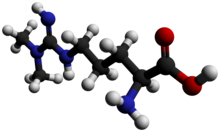Asymmetric dimethylarginine

| |

| |
| Names | |
|---|---|
| IUPAC name
2-Amino-5-[[amino(dimethylamino)methylidene]amino]pentanoic acid
| |
| Other names
N(G),N(G′)-Dimethylarginine
| |
| Identifiers | |
3D model (
JSmol ) |
|
| 3DMet | |
| 2261521 S | |
| ChEBI | |
| ChEMBL | |
| ChemSpider | |
| DrugBank | |
| KEGG | |
| MeSH | N,N-dimethylarginine |
PubChem CID
|
|
| UNII | |
CompTox Dashboard (EPA)
|
|
| |
| |
| Properties | |
| C8H18N4O2 | |
| Molar mass | 202.258 g·mol−1 |
| log P | −0.716 |
| Acidity (pKa) | 2.497 |
| Basicity (pKb) | 11.500 |
| Related compounds | |
Related alkanoic acids
|
|
Related compounds
|
|
Except where otherwise noted, data are given for materials in their standard state (at 25 °C [77 °F], 100 kPa).
| |
Asymmetric dimethylarginine (ADMA) is a naturally occurring chemical found in blood plasma. It is a metabolic by-product of continual protein modification processes in the cytoplasm of all human cells. It is closely related to L-arginine, a conditionally essential amino acid. ADMA interferes with L-arginine in the production of nitric oxide (NO), a key chemical involved in normal endothelial function and, by extension, cardiovascular health.
Discovery
Patrick Vallance and his London co-workers first noted the interference role for asymmetric dimethylarginine in the early 1990s.[1] Today biochemical and clinical research continues into the role of ADMA in
Synthesis and regulation in the body
Asymmetric dimethylarginine is created in protein
ADMA concentrations are substantially elevated by native or oxidized
ADMA and suggested lines of therapeutic research

With raised levels of ADMA seemingly to be associated with adverse human health consequences for cardiovascular disease, metabolic diseases, and also a wide range of diseases of the elderly, the possible lowering of ADMA levels may have important therapeutic effects. However, it has yet to be established whether ADMA levels can be manipulated and, more important, if this results in useful clinical benefits.
The association of ADMA with abnormalities of lipid regulation suggested that supplements of free fatty acids might manipulate ADMA levels. However, research has failed to show that these have an effect.[4][5]
ADMA's role has been linked with elevated levels of
Direct alteration of ADMA levels with supplements of L-arginine have been suggested.[12][13] The hope is that such intervention might not only improve endothelial function but also reduce clinical symptoms of overt cardiovascular disease.[14][15] However studies show inconsistency in results in a clinical context,[16] and the recent results with manipulating homocysteine levels warrant extreme care with what clinical outcomes might arise from this approach.
Statins, as well as affecting circulating cholesterol levels, also increase nitric oxide levels and so have a direct effect on blood supply to the heart. Elevated levels of ADMA seems to modify this effect and so may have consequences for patients' responsiveness to taking statins.[17]
Repeated administration of d-amphetamine may decrease ADMA in mice.[18]
See also
References
- S2CID 38113918.
- PMID 7536038.
- PMID 10903992.
- PMID 16396682.
- S2CID 260169813.
- PMID 16414052.
- S2CID 24645709.
- PMID 15720202.
- S2CID 37275349.
- S2CID 21790155.)
{{cite journal}}: CS1 maint: numeric names: authors list (link - PMID 16531614.
- PMID 14518608.
- ISBN 0-7679-0881-3.
- PMID 8925582.
- PMID 9264427.
- PMID 15465788.
- S2CID 36938530.
- PMID 29946233.
